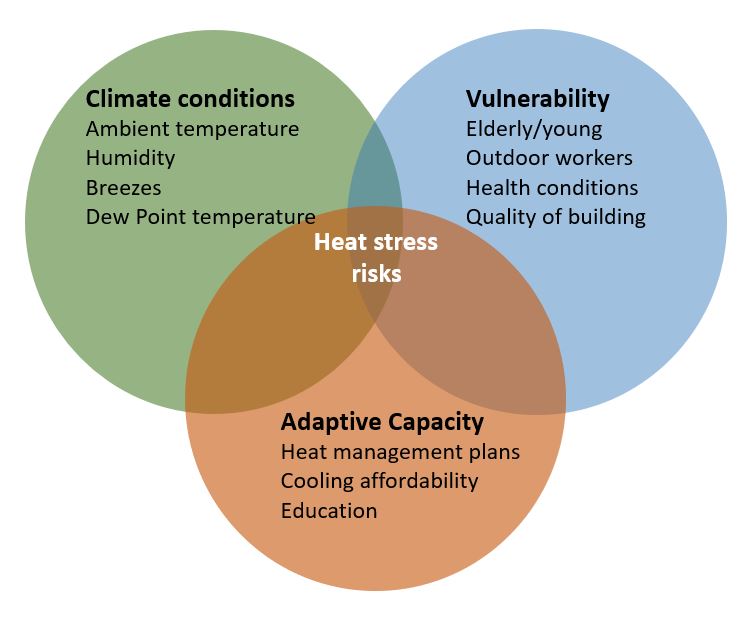Staying cool
in the city
Managing heat stress risks
Heat stress risk is not just a function of people being exposed to a hot and humid climate but also what they are doing and who they are. Darwin locals often adapt their daily routines to manage heat stress risks by adapting their behaviour.
- Wearing light clothing NT Government advice on beating the heat
- Drinking more water to stay hydrated
- Having a break from strenuous physical activities
- Staying out of the sun
- Retreat to a cooler space, such as air conditioned room or under a tree

Heat stress risks
Vulnerability – While access to air-conditioned spaces can help to manage heat stress risks, particularly during the build-up and wet seasons. However, it has been shown that relying on air-conditioning can exacerbate existing inequities for vulnerable population groups due to the energy running costs2. Vulnerable population groups to heat stress include the very young and the elderly, and those with underlying health conditions, and in Darwin it is likely that Indigenous people are more likely to have risk factors that make them vulnerable to heat stress3.
Adaptive capacity – Effective communication can help build awareness in the Darwin community on how to stay cool during hot and humid conditions. There is also the potential to develop heat management plans that could help Darwin coordinate and prepare and respond to periods of potential heat stress, particularly for parts of the community identified as vulnerable to heat stress.

References
- Goldie, J.; Sherwood, S. C.; Green, D.; Alexander, L., Temperature and Humidity Effects on Hospital Morbidity in Darwin, Australia. Annals of Global Health 2015,81, (3), 333-341.
- Farbotko, C.; Waitt, G., Residential air-conditioning and climate change: voices of the vulnerable. Health Promotion Journal of Australia 2011, 22, (4), 13-15.
- Oppermann, E.; Brearley, M.; Law, L.; Smith, J. A.; Clough, A.; Zander, K., Heat, health, and humidity in Australia’s monsoon tropics: a critical review of the problematization of ‘heat’ in a changing climate. WIREs Climate Change 2017,8, (4), e468.
ACKNOWLEDGEMENT
Your Tropical City acknowledge the Larrakia people as the Traditional Owners of the Darwin region and pay our respects to Larrakia elders past and present. We are committed to a positive future for the Aboriginal community.
564 Vanderlin Drive,
Berrimah NT 0828
(08) 8944 8436
hello@yourtropicalcity.com.au
PARTNER
ACKNOWLEDGEMENT
Your Tropical City acknowledge the Larrakia people as the Traditional Owners of the Darwin region and pay our respects to Larrakia elders past and present. We are committed to a positive future for the Aboriginal community.
CONTACT
564 Vanderlin Drive,
Berrimah NT 0828
(08) 8944 8436
hello@yourtropicalcity.com.au
PARTNER